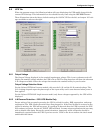
Initial Startup and Electrical Checks
18
7.0 INITIAL STARTUP AND ELECTRICAL CHECKS
Initial Startup and the Configuration Program—The UPS ships with a default 120 VAC L-N
setting. This is also the most robust setting in that it can operate with either input phase angle (120
or 180 degrees). Perform initial system checks first. If the UPS configuration needs to be modified for
your application, then go to the next section to review use of the configuration program. Some config-
uration changes require that the UPS be in the OFF mode while powered from the utility. Therefore,
the installer must confirm that the UPS input has been properly wired. After re-configuring your
UPS, the UPS may be put into service with the intended loads.
7.1 Hardwire Input Connections
1. Verify that the input and output circuit breakers are off. (To locate the circuit breakers, see
Figure 1.)
2. During initial system checks, disconnect all loads (open load disconnects).
3. Inspect all wiring, cables and connection.
4. If external battery cabinets are used, verify that the battery interconnect cables are fully inserted
into the sockets.
5. Turn on the battery cabinet circuit breaker.
6. Locate the UPS/Bypass circuit breaker on the rear of the UPS (see Figure 1).
7. Unscrew the thumbscrew and slide the bracket to the right (toward the Input Lamp) until it is
past the arm of the breaker.
8. After the bracket has been moved to right, tighten the thumbscrew to secure the bracket in place.
9. Turn the UPS/Bypass circuit breaker to Bypass (On).
10. Turn on the branch circuit disconnect to apply voltage to the input terminal block (see 6.3.1 -
Distribution Module Electrical Connections).
11. Using a voltmeter, verify the expected L1-N, L2-N and L1-L2 voltages.
a. The Input and Output lamps by the UPS/Bypass breaker will be illuminated.
b. If the configuration program as been used to set the L-N voltage at 100, 110, or 115, then the
input phase angle is required to be 180 degrees.
c. If the configuration program as been used to set the L-N voltage to 127 VAC, then the input
phase angle is required to be 120 degrees (leading or lagging).
12. After verifying proper input voltage to the UPS terminal block, turn off the branch circuit power
and close all access panels to the distribution box.
13. Unscrew the thumbscrew and slide the bracket to the left (toward the Output Lamp) until it is
past the arm of the breaker.
14. After the bracket has been moved to left, tighten the thumbscrew with your hand or use a slotted
screwdriver to secure the bracket in place.
15. Turn the UPS/Bypass circuit breaker to the Inverter (OFF) position.
16. Reapply input power.
17. Close the input circuit breaker located on the rear panel of the UPS. The green AC Input indicator
should illuminate on the front panel.
!
WARNING
Miswiring power to the input terminal block (L1-L2-N-G) or connecting to single-phase
voltages (L-N-G only) may damage the UPS.
NOTE
When the UPS is operating in manual bypass mode of operation, indicators A, C, E, Fault and
Bypass will be illuminated. These indicators, on the front panel, signify the UPS is operating
in Manual Bypass mode. There will be audible alarm as well.
NOTE
When the UPS/Bypass circuit breaker is in the Inverter position, Indicators A, C, E, Fault and
Bypass will not be illuminated and the audible alarm will clear.


















